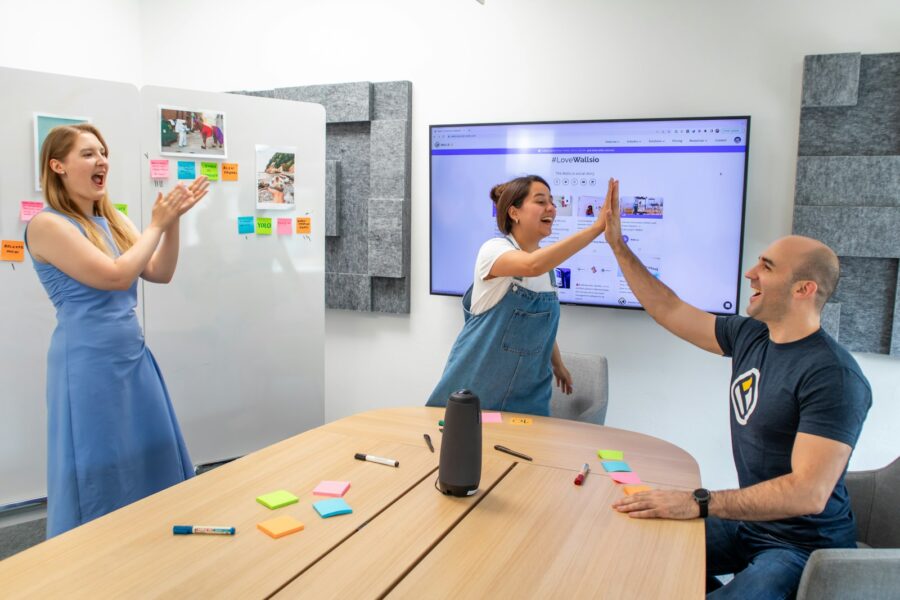Did you know?
- 49% of employees feel that their organisation isn’t delivering on the experience they promised.
- Engaged organisations see 59% less employee turnover.
- Employees that have a good experience are 16 times more engaged than employees with a negative experience.
What is the Employee Experience (EX)?
Most of us are familiar with the term customer experience, but Employee Experience (EX) is a relatively new concept which is becoming increasingly prevalent for forward-thinking organisations who are looking to create a work environment that attracts the best talent and ensures they stay as long as possible.
Simply put, the employee experience is the journey an employee takes with an organisation from pre-boarding all the way through to offboarding and everything in between! It includes each and every interaction that happens along the employee lifecycle involving the employee’s workspace, wellbeing, manager and career development.
The way we think about EX should be considered as a natural extension of the company’s strategy and culture, as it’s important employees feel aligned with an organisation’s goals. When employees understand and resonate with the company’s mission and values, they are more likely to be motivated and committed. This alignment creates a cohesive work environment where everyone works towards common objectives, which in turn drives both employee satisfaction and good commercial outcomes.
Designing the Employee Experience
For anyone wondering where to start with creating a great employee experience, it is a strategic process that involves careful planning that optimises each touchpoint an employee has with an organisation. Generally, it requires input from most, if not all, divisions in an organisation.
There are 2 key elements to this process.
- Employee personas. As any marketing department will develop customer personas – the same should be done for employees – as each will have different needs. Companies may have to consider designing EX by role, industry, division, geography and so on. For example, the needs of a front-line worker will be vastly different from someone who works in the office.
- Identifying milestones that matter. These are the pivotal points in the employee lifecycle that, when optimised, significantly enhance the overall experience. Similarly, there will be moments where ‘pain points’ are more likely and these should also be addressed. While specific moments vary by company, they generally align with common stages in most organisational employee journeys.
Addressing the disconnect in EX promised Vx EX delivered
If almost half of all employees feel that organisations are failing to deliver on the experience they promised – what is the cause of this?
Firstly, there is an over-reliance on managers to drive and own the employee experience. When managers are solely responsible for shaping the experience, their actions often diverge from the broader business strategy, focusing more on what they can implement rather than what the organisation needs.
Secondly, companies tend to focus too much on engagement metrics rather than on the experiences that drive engagement. This well-intentioned focus on achieving high engagement scores often leads to actions that do not align with the company’s culture and strategy, resulting in limited impact on business outcomes.
Lastly, many organisations use surveys as a ‘feel-good’ or ‘tick box’ process rather than as tools to drive meaningful change. These surveys often measure the same foundational elements – rather than leveraging them to illicit more useful information.
Strategies to Boost Employee Experience
The workplace is changing.
Employees are looking for purpose, trust, social connection and they want to feel their work is valued. Companies that deliver genuine, personalised experiences that enhance an employees’ sense of purpose, whilst creating an open and transparent environment, are the ones that will reap the rewards.
There are a number of important milestones or factors when thinking about designing a best-in-class employee experience.
#1 Don’t Neglect the Pre-boarding Period
With a one to three-month gap before starting a new job – this period can be used for pre-boarding activities to ensure the new hire maintains interest in the job and employee engagement. This is the perfect opportunity for companies to put their best foot forward.
This could include sending welcome packs, making intros to mentors and other key staff, sending out a survey of what the employee is looking for within the role, i.e. what really motivates them, or if there are any concerns or fears about the job. These things can then be managed head on from day 1. This is the perfect time to start a real conversation – it’s these ‘conversations’ that will be key to designing an EX that differs from most other companies.
#2 Create an Outstanding Onboarding Experience
Once you have set the scene with a great pre-boarding experience, it’s time to think about those all important first 90 days.
Set the right tone by creating clear role expectations; outline tasks, systems, projects, team objectives and individual goals.
Pairing new hires with experienced mentors provides invaluable support, guidance and insider knowledge, facilitating a smoother transition and increased confidence. Complement this by encouraging cross-departmental collaboration to ensure a holistic understanding of organisational dynamics and seamless collaboration in the future.
Managers also need to think about establishing a performance feedback loop with regular check-ins offering ongoing feedback and support in those early days, empowering new employees and promoting continuous improvement. This includes celebrating milestones throughout the onboarding journey to motivate staff and ensure continued excellence.
Finally integrating new hires into the company culture through team-building activities and social events fosters a sense of belonging. Famously, Gallup discovered that “having a best friend at work” was the biggest predicator of employee retention.
And don’t forget to regularly evaluate onboarding effectiveness through quantitative and qualitative data to ensure ongoing improvement.
#3 Invest in an Employees Development and Growth
- LinkedIn’s Workplace Learning Report indicates that 94% of employees would stay longer at a company that invests in their career development.
If companies are not seriously thinking about investing in upskilling and reskilling their employees, they could be dealing with significant attrition problems. However, a one-size-fits-all approach to the development of employees is not going to cut it. Their specific needs and skill sets should be taken into account. Providing targeted L&D, resources and guidance equips employees with the knowledge and tools necessary to hit the ground running, minimising ramp-up time and maximising engagement and productivity.
Build on the foundations of cross-functional working by continuing to nurture diverse connections across the company. Bringing together employees who might not otherwise get a chance to collaborate, on a particular initiative or project, can be instrumental in driving a culture of innovation.
#4 Introduce a Systematic Approach to Recognition and Reward
- Employees who feel recognised are 7 times more likely to be highly productive and 69% of employees say they would work harder if they felt their efforts were better appreciated.
Lack of recognition is the number one reason why employees leave their jobs.
There are many ways employees can be recognised and rewarded. Traditional methods could be through fair market pay – which greatly contribute towards a positive culture – or spot bonuses.
But there are more creative ways, such as AI-powered gamification. Using solutions like Cognexo, companies can track achievements, introduce competition and make recognition social. For instance, AI can monitor performance data to automatically award points or badges for milestones and broadcast achievements through leaderboards and across company channels.
#5 Consider Leadership’s Influence on EX
Leadership impacts every aspect of EX as they responsible for shaping most, if not all aspects of an organisational culture.
First and foremost, leaders need to provide direction and alignment. When employees have direction, things become clearer. When the internal and external components of a business are aligned, processes and tasks get completed more quickly.
But they also need to be inclusive and ensure they are listening to all team members. As organisations understand the benefits of a diverse workforce, they’re also becoming aware of the intrinsic value it brings to employee sentiment, as well as overall productivity and innovation. Sadly, a recent study showed that 25% of employees believe they don’t truly belong in their workplace, leading to performance dips and a desire to move on.
Leaders that have a ‘flexibility first’ approach and allow employees to work when they feel most productive and balanced, will create a better employee experience. This is highlighted via studies showing 86% of employees believe they would be happier if given the possibility of fully remote or hybrid work. And, leaders should not micromanage. When you hire someone, it should be because you trust their skill set and expertise.
Finally, leaders need to ensure to keep the lines of communication open. Having an ‘open door policy’ or scheduling regular 1:1s where employees can ask or air anything can be hugely beneficial. Keep these meetings informal to give employees the psychological safety to be honest about what is on their minds.
#6 Measure Sentiment Across Milestones
Employee surveys are often unpopular due to their length and complexity, leading to survey fatigue, or because they are perceived as lacking anonymity or effectiveness. However, when conducted properly, surveys can be a powerful tool for gauging employee satisfaction and engagement and in helping to continually shape and evolve the employee experience.
Companies should utilise surveys and feedback tools strategically to capture employee sentiment. Light-touch surveys, consisting of just 2 or 3 questions and integrated seamlessly into the workflow, can significantly improve response rates and answer quality. At Cognexo, we employ this approach to measure employee sentiment throughout the entire employee lifecycle, from pre-boarding to offboarding, achieving an industry-leading response rate of 91%.
By monitoring employee feedback in real-time and providing timely insights to the relevant stakeholders, we drive meaningful business transformation. Additionally, we collaborate with clients to conduct regular ‘wellbeing check-ins,’ for their employees enabling them to initiate wellness programmes and provide resources that support their mental and physical health.
#7 Structured Offboarding
- Employees who have a positive exit experience are 2.9x more likely to recommend that organisation to others.
Offboarding is a crucial aspect of the employee experience that is often overlooked. Poor offboarding practices can negatively impact a company’s ‘employer brand’ and lead to missed opportunities for valuable insights. Conducting offboarding interviews provides critical data to understand the root causes of employee attrition.
At Cognexo, we assist clients in ensuring a smooth offboarding process by asking the right questions at the appropriate times. What’s more, offboarding surveys become even more valuable when combined with other data points, such as performance metrics, employee engagement scores, demographics and customer feedback. This comprehensive approach creates a clearer understanding of the situation, as exit interviews can often be influenced by emotional factors.
However, effective offboarding programmes extend beyond surveys; they encompass in-person or phone interviews, manager and peer feedback, as well as after-action reviews with a team. This thorough approach yields deeper insights and identifies specific areas for improvement. Leaders should continuously monitor and evaluate exit data as part of evolving the employee experience.
Moving forward
EX isn’t just a buzzword; it demands a fundamental shift from a traditional top-down management model to a carefully crafted design approach with the employee firmly top of mind.
More than ever, employees are re-assessing how and why they work – so this reorientation lets companies prioritise their employees by understanding and addressing their unique perspectives and then pinpointing key milestones in their career journey and making them positive and fulfilling.
However, it’s important to create a clear North Star from, or measure for success, from the outset. This will need to be supplemented by courageous leadership and empowered managers that will develop a stable and engaging workplace.



